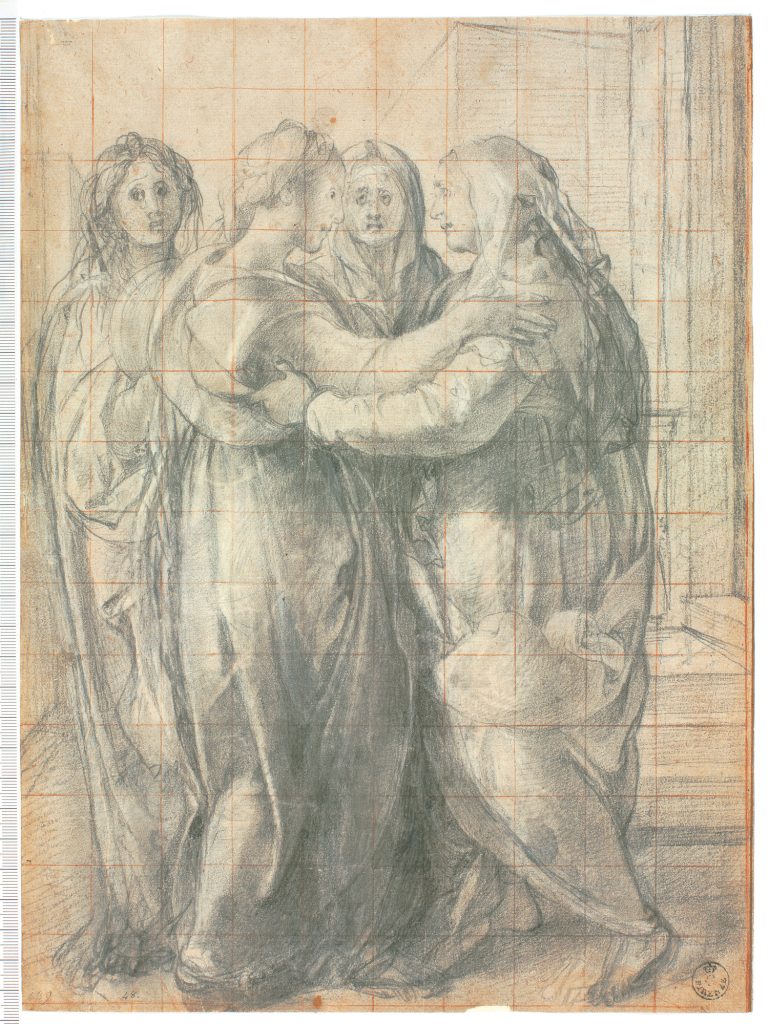If there is one museum exhibit to see this year, I cast my vote for “Pontormo: Miraculous Encounters,” at the Getty. Its centerpiece is an exquisite rendering of the “Visitation.”
The Saturday I went traffic was horrible, getting into the Getty lot and finding a space took almost half an hour, and rather than stand for God knows how long more in the TSA-style security line through which visitors now have to pass simply to get on the tram, I opted to walk up the hill.
En route, I thought about how the whole experience of getting to our beloved Getty is a microcosm of our lives as Angelenos: the car, the beauty crossed with hardship, frustration, hope, and if we’re lucky, gratitude.
I thought of the “Visitation’s” backstory: how the angel Gabriel “overshadowed” the Virgin Mary, her question — “But how can this be?” — her sublime yes. Pregnant with Christ, she’d set out on foot, traversing “the hill country” to visit her aged cousin Elizabeth who, way past childbearing age, at the time was also miraculously pregnant.
To know the backstory is to know that Elizabeth was bearing into the world John the Baptist, who would say of Christ, “He must increase, and I must decrease,” who would be a voice crying out in the wilderness, and who would be beheaded in prison at the behest of a harlot and her mother.
It’s to know that Christ, upon hearing the news of John’s death, would go to “a lonely place” to pray, and that his public ministry was beginning, and how it would end.
But before that, it’s to thrill to Elizabeth’s greeting to her beloved cousin as she glimpsed her coming over the hills: “Hail Mary, full of grace, the Lord is with thee.” So dear to the Catholic mind, heart, and soul is the encounter that we’ve enshrined it as the Second Joyful Mystery of the rosary.
Prior to viewing the exhibit, I’d opted to take in a talk: “Tradition and Innovation in Florentine Painting: Pontormo’s Visitation.”
Lecturer Bruce Edelstein, Coordinator of Graduate Programs and Advanced Research at NYU Florence, has a Ph.D. from Harvard, lives in the apparently fabulous Villa La Pietra, and spoke with great fluidity and erudition, nonstop, without notes, for almost an hour and a half.
Here I learned that Jacopo da Pontormo was a “superstar” in his day and that his “Visitation” (circa 1528-1529) was designed as an altarpiece. I learned about Venetian politics, painting, and art criticism during the period in question.
“Small but precious,” Edelstein accurately observed of the exhibit, which includes Pontormo’s preparatory drawings, two of his more exceptional portraits, and smaller works from several of his contemporaries.
But it was for the “Visitation” I’d come.
And it did not disappoint.
To be steeped in the Gospels is to gaze upon the painting and to strain, along with Mary and Elizabeth, toward fulfilling the mission of every follower of Christ: to greet, to welcome, to bear into the world new life and new love.
The notion of “pregnancy,” suggested by the general fullness of their figures, evokes a universe ever laboring to bring forth fruit. The chalky blues, greens, and pinks of their billowing robes evoke the liminal space between heaven and earth. Mary grips Elizabeth’s shoulders as if to say, “Help me out here, trusted elder.”
Elizabeth returns the gaze with profound wisdom and infinitely tender concern. Delicate gold haloes encircle the heads of the saints who, the viewer grasps at once, are about to sit down for a long, long chat.
How lucky for us that the painting found its way here; a city, unlike Florence, starved for sacred art, and where the work is sure to find an ardent reception.
And how wonderful of the Getty to give the work pride of place. It’s beautifully positioned and lit, glowing from within, guaranteed to draw every eye upward.
All the way down the hill I thought about how Pontormo’s painting, on loan from a church outside Florence, had flown across the sea to visit us, and how we, LA residents and tourists alike, had undergone our own minor kind of hardship to visit it.
Getting out of the Getty parking lot was even worse than getting in, but I didn’t even mind. Traffic was backed up to get on the 101, so I decided to take the long way home and continue up the 405.
Around Roscoe, I looked to my left and saw a sunset of liquid fire, a stab of stunning, heart-stopping beauty.
Spontaneously, alone in my car, I burst out, “My soul proclaims the greatness of the Lord, my spirit rejoices in God my savior, for He has looked with favor on His lowly servant. / From this day all generations will call me blessed: the Almighty has done great things for me, and holy is His Name. …”
That of course is the Magnificat, Mary’s reply to Elizabeth’s well-known greeting: “Hail … full of grace.” Immortalized in Luke’s Gospel, integral to our prayer life and liturgy, the passage is sung the world over by all who pray the Divine Office each evening at Vespers.
I feel sure Pontormo knew the Magnificat by heart, too. For every brush stroke in his Visitation sings with its glory, its light, its fullness, its mystery; its bowing before the Master on bended knee, its yearning, overflowing love.
Heather King is a blogger, speaker and the author of several books. For more, visit heather-king.com.
SPECIAL OFFER! 44 issues of Angelus for just $9.95! Get the finest in Catholic journalism with first-rate analysis of the events and trends shaping the Church and the world, plus the practical advice from the world’s best spiritual writers on prayer and Catholic living, along with great features about Catholic life in Los Angeles. Subscribe now!

